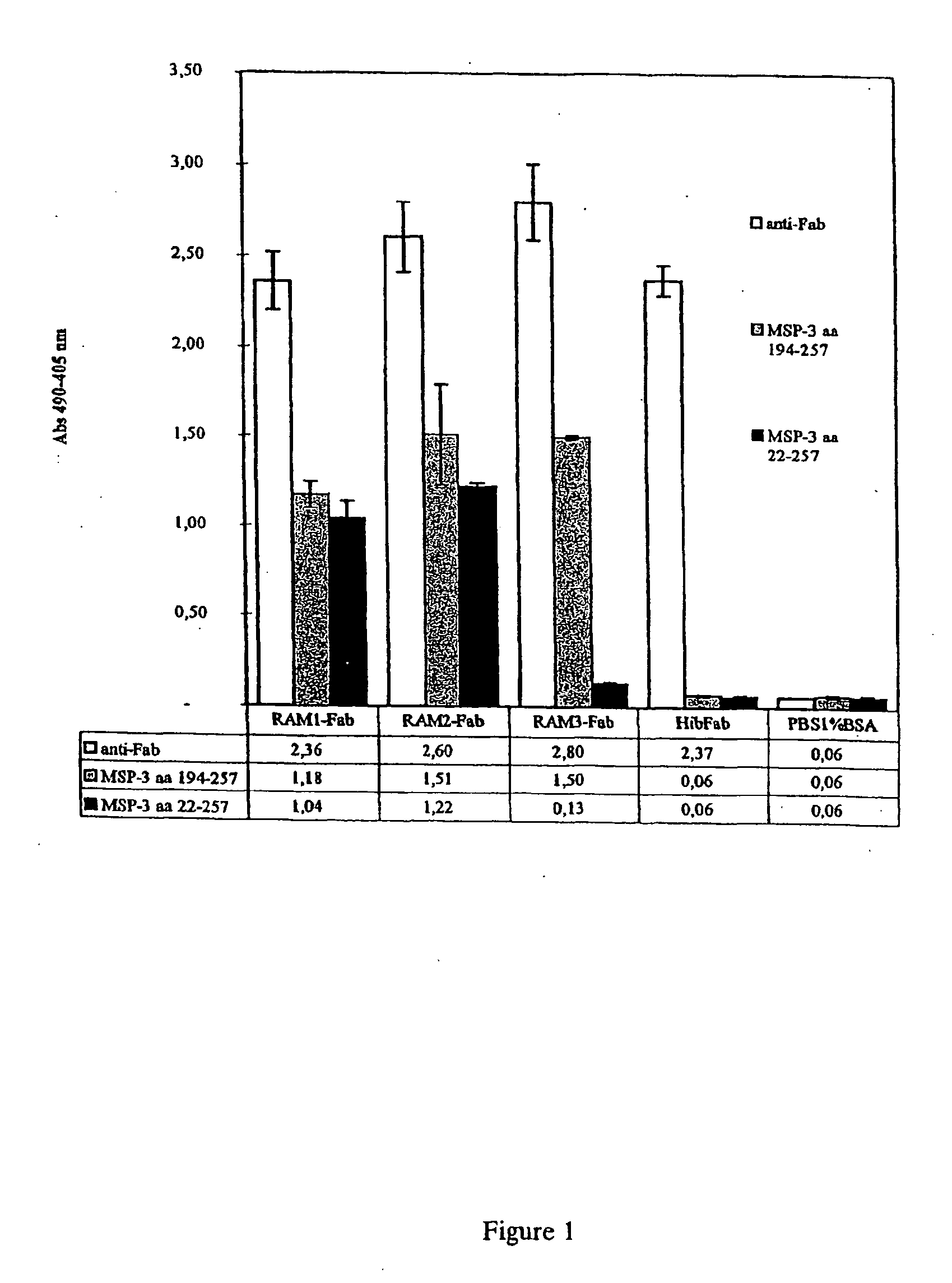Recombinant anti-plasmodium falciparum antibodies
a technology of plasmodium falciparum and anti-plasmodium falciparum, which is applied in the field of recombinant anti-plasmodium falciparum antibodies, can solve the problems of putting a devastating burden on the societies of the developing world, posing a major threat to public health, and many anti-malaria drugs are notorious for their toxic side effects, and achieve the effect of stimulating the phagocytosis of infected erythrocy
- Summary
- Abstract
- Description
- Claims
- Application Information
AI Technical Summary
Benefits of technology
Problems solved by technology
Method used
Image
Examples
example 1
[0129] Library Construction
[0130] Sampling of Peripheral Blood Lymphocytes
[0131] A volume of 100 ml peripheral blood was obtained after informed consent from each of 13 adults living in a malaria endemic area of Senegal, West Africa. The blood was collected in the anticoagulant ACD (adenine-citrate-dextrose) that conserves RNA better than heparin. The samples were transported to the laboratory where a brief centrifugation was carried out, the buffy coat aspirated and cells suspended into an RNAse protecting buffer containing guanidinium HC1, beta-mercaptoethanol and sarcosine. The material was then frozen in liquid nitrogen and shipped for further processing.
[0132] RNA Purification
[0133] RNA was isolated from the samples by acid phenol extraction according to the procedure of Chirgwin et al. (Chirgwin et al. 1979). Messenger RNA was converted to cDNA as described by Ørum et al. (1993).
[0134] PCR of Antibody Coding Genes
[0135] Amplification of antibody genes was carried out as ...
example 2
[0148] Selection
[0149] Production of Primary Phage Stock
[0150] A 50 ml culture of the library in LB medium with 50 mg / l carbenicillin, 12,5 mg / l tetracyclin and 2% glucose was superinfected with VCSM13 helper phage (Stratagene) at an OD600=0.8. A multiplicity of infection of 100 was used and the mixture was incubated at 37° C. with gentle shaking (50 rpm) for 1 h. Then the culture was diluted into 950 ml medium as above without glucose and incubated at 30° C. overnight. After a 15-min spin at 10,000 xg the supernatant containing phage was precipitated with PEG6000 and sodium chloride at final concentrations of 4% and 0.5 M respectively. The supernatant was incubated for 1 h on ice and centrifuged for 30 min at 12,000 x g. Precipitated phage was resuspended in phosphate buffered saline (PBS) with 0.1% bovine serum albumin (BSA) and used immediately. The total number of colony forming units was 1.3×103 (determined as per Sambrook et al. 1989).
[0151] Selection of Specific Binders in...
example 3
[0160] Determination of Specificity
[0161] The reactivity of the clones with native malaria antigen was demonstrated.
[0162] Direct ELISA
[0163] ELISA plates (Maxisorb, NUNC 4-39454, Denmark) were coated with 10 to 650 ng per well of purified recombinant MSP-322-257 or MSP-3194-257 or of the peptides MSP-3190-217 or MSP-3211-237 in PBS and used for standard ELISA with undiluted supernatant or supernatant diluted in PBS-BSA as previously described (Dziegiel et al.1991; Dziegiel et al. 1995). After wash, goat anti-human Fab (Sigma A8542) or anti-human IgG Fc (Sigma A9544) antibodies conjugated to alkaline phosphatase was applied as detection antibody. Finally, p-nitrophenyl phosphate (Sigma phosphatase substrate tablets, 104-105) was used as substrate. Color development was measured as OD405-OD490, see FIG. 1. RAM1 and RAM2 both bind to the short MSP-3194-257 and the long MSP-322-257 recombinant versions of the MSP-3 antigen. In contrast, RAM3 binds only the short MSP-3194-257 version...
PUM
| Property | Measurement | Unit |
|---|---|---|
| body weight | aaaaa | aaaaa |
| body weight | aaaaa | aaaaa |
| body weight | aaaaa | aaaaa |
Abstract
Description
Claims
Application Information
 Login to View More
Login to View More - Generate Ideas
- Intellectual Property
- Life Sciences
- Materials
- Tech Scout
- Unparalleled Data Quality
- Higher Quality Content
- 60% Fewer Hallucinations
Browse by: Latest US Patents, China's latest patents, Technical Efficacy Thesaurus, Application Domain, Technology Topic, Popular Technical Reports.
© 2025 PatSnap. All rights reserved.Legal|Privacy policy|Modern Slavery Act Transparency Statement|Sitemap|About US| Contact US: help@patsnap.com



